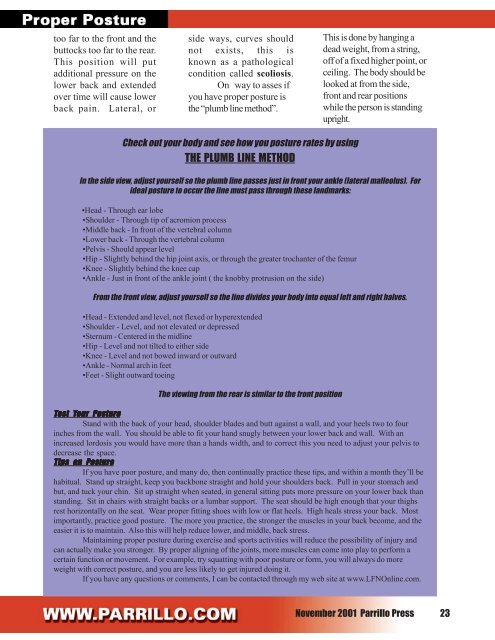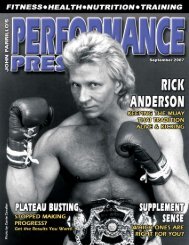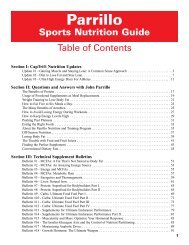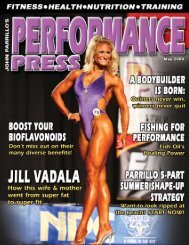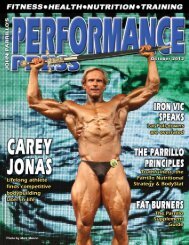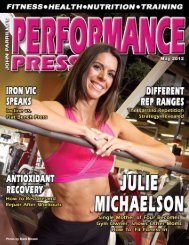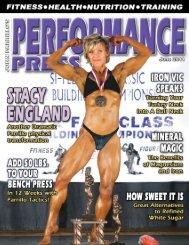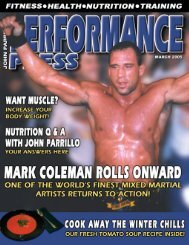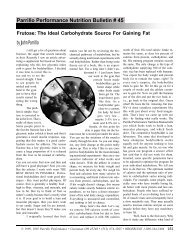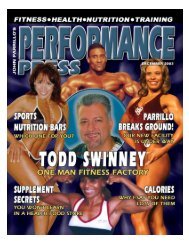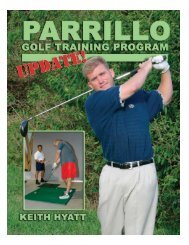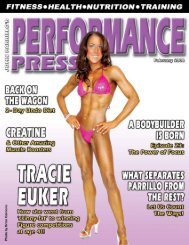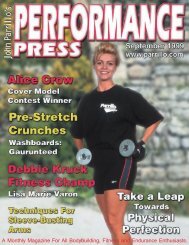Publisher - Parrillo Performance
Publisher - Parrillo Performance
Publisher - Parrillo Performance
You also want an ePaper? Increase the reach of your titles
YUMPU automatically turns print PDFs into web optimized ePapers that Google loves.
too far to the front and the<br />
buttocks too far to the rear.<br />
This position will put<br />
additional pressure on the<br />
lower back and extended<br />
over time will cause lower<br />
back pain. Lateral, or<br />
side ways, curves should<br />
not exists, this is<br />
known as a pathological<br />
condition called scoliosis.<br />
On way to asses if<br />
you have proper posture is<br />
the “plumb line method”.<br />
This is done by hanging a<br />
dead weight, from a string,<br />
off of a fixed higher point, or<br />
ceiling. The body should be<br />
looked at from the side,<br />
front and rear positions<br />
while the person is standing<br />
upright.<br />
Check out your body and see how you posture rates by using<br />
THE PLUMB LINE METHOD<br />
In the side view, adjust yourself so the plumb line passes just in front your ankle (lateral malleolus). For<br />
ideal posture to occur the line must pass through these landmarks:<br />
•Head - Through ear lobe<br />
•Shoulder - Through tip of acromion process<br />
•Middle back - In front of the vertebral column<br />
•Lower back - Through the vertebral column<br />
•Pelvis - Should appear level<br />
•Hip - Slightly behind the hip joint axis, or through the greater trochanter of the femur<br />
•Knee - Slightly behind the knee cap<br />
•Ankle - Just in front of the ankle joint ( the knobby protrusion on the side)<br />
From the front view, adjust yourself so the line divides your body into equal left and right halves.<br />
•Head - Extended and level, not flexed or hyperextended<br />
•Shoulder - Level, and not elevated or depressed<br />
•Sternum - Centered in the midline<br />
•Hip - Level and not tilted to either side<br />
•Knee - Level and not bowed inward or outward<br />
•Ankle - Normal arch in feet<br />
•Feet - Slight outward toeing<br />
The viewing from the rear is similar to the front position<br />
Test Your Posture<br />
Stand with the back of your head, shoulder blades and butt against a wall, and your heels two to four<br />
inches from the wall. You should be able to fit your hand snugly between your lower back and wall. With an<br />
increased lordosis you would have more than a hands width, and to correct this you need to adjust your pelvis to<br />
decrease the space.<br />
Tips on Posture<br />
If you have poor posture, and many do, then continually practice these tips, and within a month they’ll be<br />
habitual. Stand up straight, keep you backbone straight and hold your shoulders back. Pull in your stomach and<br />
but, and tuck your chin. Sit up straight when seated, in general sitting puts more pressure on your lower back than<br />
standing. Sit in chairs with straight backs or a lumbar support. The seat should be high enough that your thighs<br />
rest horizontally on the seat. Wear proper fitting shoes with low or flat heels. High heals stress your back. Most<br />
importantly, practice good posture. The more you practice, the stronger the muscles in your back become, and the<br />
easier it is to maintain. Also this will help reduce lower, and middle, back stress.<br />
Maintaining proper posture during exercise and sports activities will reduce the possibility of injury and<br />
can actually make you stronger. By proper aligning of the joints, more muscles can come into play to perform a<br />
certain function or movement. For example, try squatting with poor posture or form, you will always do more<br />
weight with correct posture, and you are less likely to get injured doing it.<br />
If you have any questions or comments, I can be contacted through my web site at www.LFNOnline.com.<br />
November 2001 <strong>Parrillo</strong> Press 23


